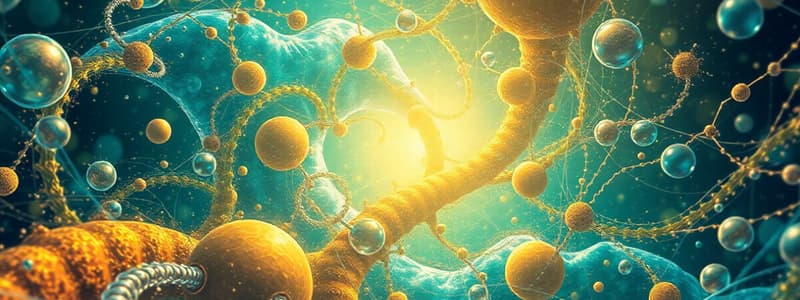Podcast
Questions and Answers
According to the Second Law of Thermodynamics, what happens to the total entropy of a system and its surroundings during a spontaneous process?
According to the Second Law of Thermodynamics, what happens to the total entropy of a system and its surroundings during a spontaneous process?
- It decreases.
- It remains constant.
- It fluctuates randomly.
- It always increases. (correct)
Why do hydrophobic molecules cluster together in water?
Why do hydrophobic molecules cluster together in water?
- To minimize interactions with other hydrophobic molecules.
- To maximize interactions with water molecules.
- To decrease the entropy of the system.
- To increase the entropy of the water molecules. (correct)
What are the properties of phospholipids that allow them to form membranes spontaneously in water?
What are the properties of phospholipids that allow them to form membranes spontaneously in water?
- They are non-polar, with no charged regions.
- They are entirely hydrophobic.
- They are amphipathic, with hydrophilic heads and hydrophobic tails. (correct)
- They are entirely hydrophilic.
Which of the following interactions is NOT a main contributor to protein folding?
Which of the following interactions is NOT a main contributor to protein folding?
What does pH measure?
What does pH measure?
What is the pH of a neutral solution?
What is the pH of a neutral solution?
If the pH of a solution is 5, what is the hydrogen ion concentration, [H+]?
If the pH of a solution is 5, what is the hydrogen ion concentration, [H+]?
What is the ion product of water ($K_w$) at room temperature?
What is the ion product of water ($K_w$) at room temperature?
What happens to the hydroxide ion concentration, [OH-], if a solution has a pH of 5?
What happens to the hydroxide ion concentration, [OH-], if a solution has a pH of 5?
How does a change in pH affect the structure of biomolecules such as proteins?
How does a change in pH affect the structure of biomolecules such as proteins?
Flashcards
Entropy
Entropy
A measure of randomness in a system. The more random, the higher the entropy.
Hydrophobic Molecules
Hydrophobic Molecules
Molecules that don't interact with water due to being nonpolar or uncharged. They tend to cluster together in water, releasing water molecules and increasing entropy.
Hydrophobic Effect
Hydrophobic Effect
The spontaneous tendency of hydrophobic molecules to cluster together in an aqueous environment. This increases the overall entropy of the system.
Amphipathic Molecules
Amphipathic Molecules
Signup and view all the flashcards
Membrane Formation
Membrane Formation
Signup and view all the flashcards
Protein Folding
Protein Folding
Signup and view all the flashcards
pH
pH
Signup and view all the flashcards
Ion Product of Water (Kw)
Ion Product of Water (Kw)
Signup and view all the flashcards
Water Ionization
Water Ionization
Signup and view all the flashcards
Acid
Acid
Signup and view all the flashcards
Study Notes
Chapter 2 Part 2: Water, Weak Bonds, and the Generation of Order Out of Chaos
- This chapter explores the importance of water and weak bonds in biological systems, focusing on how order arises from seemingly chaotic interactions.
Learning Objectives
- Understand the Second Law of Thermodynamics and its application to hydrophobic molecules.
- Describe the importance of hydrophobic interactions in membrane and protein formation.
- Define pH and understand the pH scale.
- Understand the ion product of water and its calculation.
- Define and identify conjugate acid-base pairs.
2.4 Hydrophobic Molecules Cluster Together
- The Second Law of Thermodynamics dictates that the total entropy of a system and its surroundings always increases in a spontaneous process.
- Entropy is a measure of randomness.
- Hydrophobic molecules are typically nonpolar or uncharged.
- These molecules do not interact with water.
- They cluster together in water, a phenomenon called the hydrophobic effect.
- Clustering releases water molecules, thus increasing entropy and is spontaneous.
- No energy input is required for this process
Membrane Formation
- Phospholipids are amphipathic molecules.
- The hydrophilic head groups of phospholipids interact with water, while the hydrophobic tails cluster together in the interior of the membrane.
- The hydrophobic interactions are stabilized by van der Waals forces.
Protein Folding
- Hydrophobic amino acids cluster together to facilitate protein folding.
- Other interactions like hydrogen bonds and van der Waals forces also play a role in the folding process.
2.5 pH Is an Important Parameter of Biochemical Systems
- pH measures the hydrogen ion concentration of a solution.
- pH = -log[H+]
- pH scale ranges from 0 to 14.
- pH < 7 is acidic, pH = 7 is neutral, and pH > 7 is alkaline.
- Changes in pH can affect ionic bonds and hydrogen bonds, thus altering the structure and function of biomolecules like proteins.
Water Ionization
- Water ionizes to a small extent: H₂O ⇌ H⁺ + OH⁻
- Ion Product of Water (Kw): Kw = [H⁺][OH⁻] = 1.0 x 10⁻¹⁴ M
Conjugate Acid-Base Pairs
- Acids are proton donors, and bases are proton acceptors.
- Conjugate acid-base pairs arise when an acid donates a proton to form its conjugate base, or when a base accepts a proton to form its conjugate acid.
- Example: Acetic acid (CH₃COOH) ionizes to form acetate (CH₃COO⁻) and a hydrogen ion (H⁺).
Buffers
- Conjugate acid-base pairs act as buffers, resisting changes in pH.
- Buffering capacity is greatest near the pKₐ of the weak acid component.
- pKₐ is the pH at which the acid component is half-dissociated
Importance of pH
- Understanding how buffers wok and maintain pH is critical for studying molecules in vitro and understanding cellular processes in vivo, where maintaining pH is essential for cell survival.
Studying That Suits You
Use AI to generate personalized quizzes and flashcards to suit your learning preferences.



